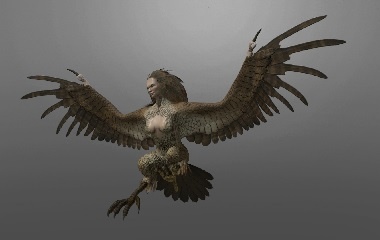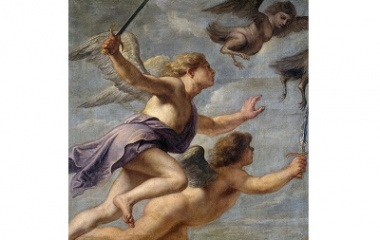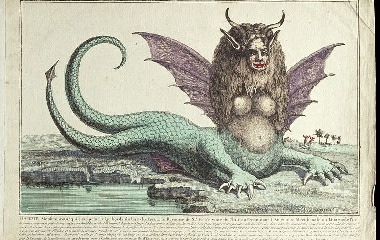What is a Harpy?
The Harpy is a mythical creature that arose from Greek mythology. It is thought that they were originally wind spirits who, over time, transformed into the fearsome creatures we know today. There are some theories that they were meant to personify the destructive nature of wind. Others, however, see them as a force created to show the power of the gods – specifically Zeus – who they were thought to take orders from.

Regardless of their origin, the Harpies were known to inspire fear and terror. There are at least four different Harpies that have been named in literature, though it is though that there are at least six sisters (due to the legends of the daughters of Aiolos).
The Harpies were known to have the power of swift winds and were capable of flying at incredible speeds that could not be matched. They were often sent by Zeus to punish those who were disobedient and were known to torment their victims as they carried them of to Tartarus.
This legend was often used to explain strange and sudden disappearances. When a person disappeared from the earth and could not be found, it was often said that the Harpies were responsible for the misfortune. This was said to be the fate of the daughters of King Pandaerus – which only served to reinforce the fear surrounding these strange creatures. The Harpies were known to be violent and full of wrath. They were also hypothesized as being guardians of the underworld along with monsters like Scylla, Chimera, and the Gorgons.
However, the Harpies did not always punish their victims with a violent trip to Tartarus. They were also known to pester their victims by stealing food and soiling over any remaining scraps. This method of punishment is listed at least twice in literature – once in the story of King Phineus and once in the story of the Trojans.
Home of the Harpies
It is thought that the Harpies could have resided in several areas including the Strophades (plural), near the entrance of Orcus, or a Crete cave. Of these locations, the most popular seems to be Strofades (singular).

It is said that the Harpies came to reside in Strofades when they were discovered to be torturing a blinded King Phineus by stealing his food before he could eat. The Agronauts happened upon the island and saw what was happening. When they spoke to the king, they discovered King Phineus had information that was vital to the Agronaut’s mission and would only give it to them in exchange for rescue from the Harpies.
Two of the Argonauts, Zetes and Calais, chased the Harpies as far as the Strophades before the fastest of the Harpies (Ocypete) collapsed in exhaustion. She prayed to the gods to be rescued from the Argonauts. In response, Iris appeared and stopped Zetes and Calais from killing the Harpies. She promised that king Phineus would never be bothered by the creatures again.
The Argonauts returned to their mission and the Harpies remained on the island. Thus, the islands were named Strofades (meaning Islands of Turning) because the Argonauts were turned away before killing the Harpies.
Physical Appearance
There are two rivaling descriptions of the Harpies. There are some sources that claim that the Harpies were beautiful creatures with the heads of maidens and the body of a bird of prey. They were also portrayed as creatures of great beauty. They were often depicted as being beautiful women with wings (and sometimes claws and talons for feet and hands).
However, rivaling sources claim the Harpies were terrible creatures with ugly features. They were said to have a face that was so terrible it could not even be compared to that of a gargoyle and they were spoken of with disdain. In fact, some writers described them as being ‘human vultures.’
This version of the Harpy (which is the most popular), portrays the Harpies as having faces that are always pale with hunger and especially harsh in their appearance. They are often described as being of ill hygiene and having a foul stench that is unbecoming.
Those who believe the second description of the Harpies sometimes connect these creatures in relation to the Gorgons. It is said that these two groups of sisters were thought to be cousins – which could explain where the myth of a Harpy’s terrible features came from in the beginning.
Mythical Alliances and Connections
Zeus
Mythology often connects the Harpies to Zeus and it was thought that they often did Zeus’ bidding. He is known to have used them to punish King Phineus and the daughters of King Pandarus.
Iris
It is known that Iris (goddess of rainbows and messenger of the gods) is a sister to the Harpies, having also descended from Thaumas and Electra.

She is also the goddess responsible for ensuring that the lives of the Harpies would be spared when they were chased to the Strofades by the Argonauts.
Thaumas
Thaumas was a sea god who was born of Pontus and Gaia. He was thought to be married to Electra, and to have given birth to the Harpies with her.
Typhon
Typhon was known to be one of the most deadly creatures in Greek mythology. Alternate stories claim that he – not Thaumas – was the father to the Harpies. This version of the story likely comes from the same version that claims that the Harpies were ugly creatures that were cousins of the Gorgons.
Electra
Electra was an Oceanid that was joined in marriage to the sea god Thaumas. Most stories that reference the birth of the Harpies credit her with being the mother.
Famous Harpys in Mythology
Aello
Aello is one of the Harpies who is described by Hesiod in his writings. She is described as a fair maiden by Hesiod, though others who speak of her describe the Harpy as a foul creature.
Her name means ‘storm swift.’ She is also recognized in literature sometimes as ‘Aellopus’ or ‘Nicothoe.’
It is thought that she was the mother to the immortal steeds, Balius and Xanthus. Other sources, however, credit the same offspring to Celaeno or Podarge. Aello is also said to have mothered Xanthus (presumably different horse) and Podarkes – the horses of Athenian Kin Erechtheus. These horses were thought to be fathered by Boreas (the North Wind).
Ocypete
Ocypete is the second Harpy who was depicted in Hesiod’s writings. Her name translates to ‘swift wing’ and she was known to be the fastest of all the Harpies and all winged creatures, though she was driven to exhaustion when chased by the Boreads in the story of the Harpies and King Phineus.
Her name is also sometimes spelled Ocypode (meaning swift foot), or as Ocythoe (meaning swift runner).
Celaeno
Celaeno was also recognized as a Harpy sister. Her name translates to ‘the dark one.’ She is also found as Celeno, Kelaino, and Calaeno.
On the isle of Strophades, the Trojans encountered the Harpies when they slew their cattle and prepared a feast. The Harpies came down from the skies and devoured the feast, soiling any scraps that were left behind so they could not be consumed. Again the Trojans prepared a feast – this time in an enclosed and more protected area – but to their dismay, the Harpies swooped down again and devoured the food. Finally, the Trojans prepared to fight the creatures. They were stopped when Celaeno delivered a prophecy that chilled them to the core. She cursed their mission and told them that their troops would be cursed with famine so great that they would be driven to eat their own tables for their wrongful attack on the Harpies. The Trojans were filled with terror and fled the island with haste.
Podarge
Podarge is another Harpy sister. She is thought to have formed a union with Zephyrus (the god of the West Wind) and was thought to be the mother of Balius and Xanthus (the immortal horses of Achilles).
Interestingly enough, Iris (sister of the Harpies and rainbow goddess) was sometimes referred to as Podarge, making some wonder if there was a deeper connection.
Harpies in Mythology
The Daughters of King Pandareus are Punished
The tale of the Daughters of Pandareus begins when King Pandareus decides to steal a bronze dog from Zeus. When Zeus discovers who is responsible for the theft he kills King Pandareus and his wife, but allows the daughters to live. Aphrodite raises the girls until they reach womanhood and can be married. The goddess traveled to Olympus to ask Zeus for his blessing to arrange marriages for the girls.
While Aphrodite is gone, the Harpies come and steal the girls away and hand them over to the Furies. The girls are tortured and forced into servanthood for the rest of their lives because of their father’s crimes.
King Phineus is Punished
Zeus once granted King Phineus the gift of prophecy. However, when the King uses the gift against the gods, Zeus becomes angry and decides to punish the foolish King.
King Phineus was blinded and made to live on an island. Zeus sent the Harpies to torture the King by stealing away all his food before he had a chance to eat. Any scraps they left behind were soiled, further adding to the plight of the King.
Years later, the Argonauts ventured onto the island and discovered the King. They offered to drive the Harpies away from him in exchange for vital information to help their journey. The King agreed and a trap was set for the Harpies.
The Harpies, however, were very speedy. They flew across the land and managed to make it to the Strofades before collapsing with exhaustion. They prayed to the gods to have mercy on them and their cry was answered. Iris appeared and told the Agronauts to spare the lives of the Harpies. In return, they would no longer torture King Phineus.
The Trojans are Cursed
In the tale of Aeneas and the Trojans, the troops encounter the Harpies on the isle of Strofades. They attempt to have a feast on the island but are interrupted when the Harpies swoop down and devour the entire meal. This happens again and the men decide to fight the Harpies off. For their unwarranted attack (as Strofades belonged to the Harpies) the Harpies cursed the Trojans and caused them to flee in terror.
Origin of the Harpy Myth
The origins of the Harpy myths remain speculative at best. There are many who believe that the Harpy creature was simply created in order to describe the wrathful nature of raging storm winds (which often accompanied lightning). This combination could have been the basis for the creation of the Harpies and their ties with Zeus. As Zeus was thought to be the most powerful god, it makes sense that the ferocity of storms would have been attributed to his will.
It is also possible that the Harpy was simply created to serve as a moral reminder. We see these creatures being associated with punishing those who are guilty of misdeeds and those who have gone against the will of Zeus. Their creation could have arisen from the need to find a way to express the extent to which Zeus’ anger could reach.
Another explanation for the creation of these creatures could have been to serve as a learning tool. Whenever a person disappeared from a society, it was often blamed on the Harpies. This makes it likely that the Harpies were created to explain missing persons cases and serve as a warning of what could happen when a person was not of good virtue or wandered too far on their own.









